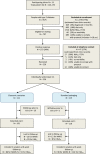Does electronic monitoring influence adherence to medication? Randomized controlled trial of measurement reactivity
- PMID: 24573909
- PMCID: PMC4223537
- DOI: 10.1007/s12160-014-9595-x
Does electronic monitoring influence adherence to medication? Randomized controlled trial of measurement reactivity
Abstract
Background: Electronic monitoring is recommended for accurate measurement of medication adherence but a possible limitation is that it may influence adherence.
Purpose: To test the reactive effect of electronic monitoring in a randomized controlled trial.
Methods: A total of 226 adults with type 2 diabetes and HbA1c ≥58 mmol/mol were randomized to receiving their main oral glucose lowering medication in electronic containers or standard packaging. The primary outcomes were self-reported adherence measured with the MARS (Medication Adherence Report Scale; range 5-25) and HbA1c at 8 weeks.
Results: Non-significantly higher adherence and lower HbA1c were observed in the electronic container group (differences in means, adjusting for baseline value: MARS, 0.4 [95 % CI -0.1 to 0.8, p = 0.11]; HbA1c (mmol/mol), -1.02 [-2.73 to 0.71, p = 0.25]).
Conclusions: Electronic containers may lead to a small increase in adherence but this potential limitation is outweighed by their advantages. Our findings support electronic monitoring as the method of choice in research on medication adherence. (Trial registration Current Controlled Trials ISRCT N30522359).
Figures
Comment in
-
The critical importance of medication adherence and its assessment: a comment on Sutton et Al.Ann Behav Med. 2014 Dec;48(3):287-8. doi: 10.1007/s12160-014-9616-9. Ann Behav Med. 2014. PMID: 24722963 No abstract available.
Similar articles
-
Adherence to Oral Glucose-Lowering Therapies and Associations With 1-Year HbA1c: A Retrospective Cohort Analysis in a Large Primary Care Database.Diabetes Care. 2016 Feb;39(2):258-263. doi: 10.2337/dc15-1194. Epub 2015 Dec 17. Diabetes Care. 2016. PMID: 26681714 Free PMC article.
-
Effect of diabetes drug counseling by pharmacist, diabetic disease booklet and special medication containers on glycemic control of type 2 diabetes mellitus: a randomized controlled trial.J Med Assoc Thai. 2005 Sep;88 Suppl 4:S134-41. J Med Assoc Thai. 2005. PMID: 16623018 Clinical Trial.
-
Continuous Glucose Monitoring vs Conventional Therapy for Glycemic Control in Adults With Type 1 Diabetes Treated With Multiple Daily Insulin Injections: The GOLD Randomized Clinical Trial.JAMA. 2017 Jan 24;317(4):379-387. doi: 10.1001/jama.2016.19976. JAMA. 2017. PMID: 28118454 Clinical Trial.
-
Efficacy and safety of generic exenatide injection in Chinese patients with type 2 diabetes: a multicenter, randomized, controlled, non-inferiority trial.Acta Diabetol. 2020 Aug;57(8):991-1000. doi: 10.1007/s00592-020-01510-y. Epub 2020 Mar 23. Acta Diabetol. 2020. PMID: 32206903 Clinical Trial.
-
Electronic measurement of medication adherence in pediatric chronic illness: a review of measures.J Pediatr. 2011 Oct;159(4):528-34. doi: 10.1016/j.jpeds.2011.05.018. Epub 2011 Jul 1. J Pediatr. 2011. PMID: 21722917 Free PMC article. Review. No abstract available.
Cited by
-
Real-World Adherence to Oral Methotrexate Measured Electronically in Patients With Established Rheumatoid Arthritis.ACR Open Rheumatol. 2019 Sep 6;1(9):560-570. doi: 10.1002/acr2.11079. eCollection 2019 Nov. ACR Open Rheumatol. 2019. PMID: 31777840 Free PMC article.
-
Design and rationale for the "Me & My Heart" (eMocial) study: A randomized evaluation of a new smartphone-based support tool to increase therapy adherence of patients with acute coronary syndrome.Clin Cardiol. 2019 Nov;42(11):1054-1062. doi: 10.1002/clc.23254. Epub 2019 Sep 6. Clin Cardiol. 2019. PMID: 31490566 Free PMC article. Clinical Trial.
-
HIV-Infected Ugandan Women on Antiretroviral Therapy Maintain HIV-1 RNA Suppression Across Periconception, Pregnancy, and Postpartum Periods.J Acquir Immune Defic Syndr. 2016 Apr 1;71(4):399-406. doi: 10.1097/QAI.0000000000000874. J Acquir Immune Defic Syndr. 2016. PMID: 26495883 Free PMC article.
-
A systematic review of interventions to improve adherence to endocrine therapy.Breast Cancer Res Treat. 2019 Feb;173(3):499-510. doi: 10.1007/s10549-018-5012-7. Epub 2018 Nov 1. Breast Cancer Res Treat. 2019. PMID: 30387003 Free PMC article.
-
Protocol for MAAESTRO: Electronic Monitoring and Improvement of Adherence to Direct Oral Anticoagulant Treatment-A Randomized Crossover Study of an Educational and Reminder-Based Intervention in Ischemic STROke Patients Under Polypharmacy.Front Neurol. 2018 Dec 21;9:1134. doi: 10.3389/fneur.2018.01134. eCollection 2018. Front Neurol. 2018. PMID: 30622509 Free PMC article.
References
-
- Saini SD, Schoenfeld P, Kaulback K, Dubinsky MC. Effect of medication dosing frequency on adherence in chronic diseases. Am J Manag Care. 2009;15:e22–e33. - PubMed
Publication types
MeSH terms
Substances
Grants and funding
LinkOut - more resources
Full Text Sources
Other Literature Sources
Medical
Miscellaneous



